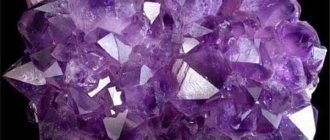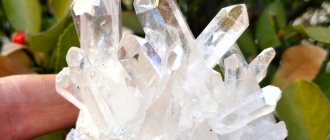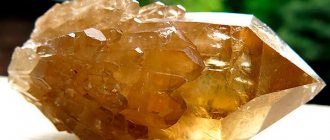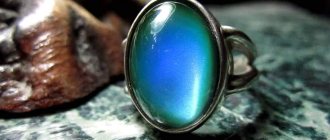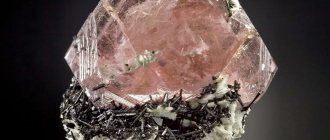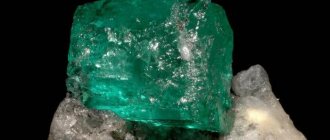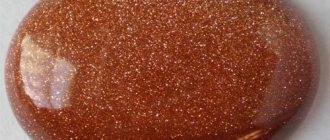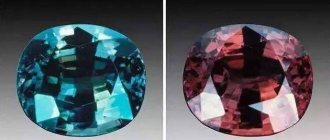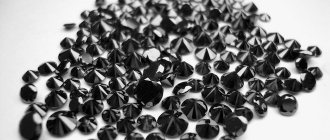Romantic epic of stone
The history of the discovery of the stone dates back to the times of the Spanish Conquest on the American continent.
Don Felipe de Urriola y Goitia, who led a detachment of conquistadors, fell in love with the daughter of the leader of the Aureios tribe, the beauty Anahai. The love turned out to be mutual, and the dowry was a mine with gems.
The husband intended to take his wife to his homeland, but the natives decided to put an end to the invaders. Anakhai was also not spared for treason. She managed to warn her husband and present him with an unusual two-color stone. They were never destined to meet again.
Raw mineral Ametrine
The detachment left the New World, taking away a stone that became a symbol of opposing feelings: loyalty to the native tribe and the invader spouse. The conquistador presented it to the monarch. The Queen of Spain wore ametrine constantly.
The world presentation of the stone took place three hundred years later, in 1980.
History and origin
In Europe, people learned about this amazing two-color mineral in the 16th century. The Spanish queen was the first to have the good fortune to decorate herself with a wonderful stone. The “two-color amethyst” was presented to her as a gift from the conqueror of the New World, who served the Spanish Crown.
A conquistador who married a Bolivian woman was given the ametrine deposit as a dowry into the possession of the leader of an Indian tribe.
According to legend, the Indian princess was never able to sail to Spain with her husband, as she was killed by her own people, who rebelled against the yoke of the invaders. Already leaving this world, the Bolivian woman gave her husband a purple and golden stone. The gem became a symbol of her heart, which shared the love for the people and her chosen “foreigner”.
A polychrome mineral with characteristics of citrine and amethyst is extremely rare in nature. Finding a multizonal gem that includes two types of crystals is a great success for geologists.
True ametrine, reminiscent of citrine and amethyst, is mined only in the central part of South America. But there is a way to obtain a crystal using a synthetic method. Artificial analogues of stones are grown at the Institute of Experimental Mineralogy.
Physico-chemical characteristics
The composition of the mineral ametrine is silicon oxide, a transparent polychrome variety of quartz.
Other characteristics of the stone:
- chemical formula – SiO2;
- color – violet-purple, with lilac or yellowish tint;
- hardness on the Mohs scale – 7;
- density – 2.60 g/cm3;
- luster – glassy.
Other names of the stone that emphasize its origin are amethyst-citrine, bicolor amethyst, bolivianite.
| Chemical formula | SiO2 |
| Selection form | prismatic crystals, druzy |
| Color | violet-lilac with yellow, lilac or yellowish-peach |
| Transparency | translucent, transparent |
| Hardness | 7 |
| origin of name | from the names of the components: amethyst and citrine |
| Zodiac sign | Leo Aries |
| Mineral deposits | USA Russia (Irkutsk region) Brazil Bolivia |
In ametrine crystals, the color is distributed chaotically: it is zoning with alternating violet-lilac (amethyst) and yellow (citrine) segments or pyramidal with increasing edges.
The amount and ratio of impurities creates different colors of ametrine: thick violet, lilac, lilac in a duet with orange or yellow.
History of ametrine stone
In the 16th century, people became acquainted with this wonderful mineral. The Bolivian leader gave his beautiful daughter named Anahi in marriage to Philip de Urriolla, a Spanish conquistador. Her father gave her a dowry in the form of a mine in which an amazing purple-golden stone was mined. True, the spouses were unable to build a happy family life. The conquistador was forced to leave Bolivia. Before his departure, his fellow tribesmen killed the beautiful Anahi. Before her death, the girl brought a two-colored ametharine as a gift to her lover as a symbol of her own heart, which is torn between love for her husband and her people.
Jewelry experts in most cases call ametrine “two-color amethyst” or “bolivite.” It is a variety of ordinary quartz, but is striking in its unique polychrome coloring.
In the structure of the ametrine stone, two minerals are intertwined - purple amethyst and golden citrine. The extraordinary palette of colors is due to the alternation of these two gems. They give the stone tints of violet, lilac, yellow-peach and lilac colors.
Ametrine deposits
The main source of high-quality raw materials is the Anahi mine (Bolivia, Central America). Local stones are beautiful and do not need processing. It is no coincidence that the second name of the mineral is bolivianite. It is the most expensive of the ametrines.
Ametrine mining
Deposits in Brazil and Siberia account for the remaining 10%, but the quality is worse. Ametrine from Brazil is not so bright, and Siberian samples are golden-smoky.
Amethysts and citrines are mined all over the world, however, ametrine has not been found anywhere else.
How to distinguish a fake?
The real stone is rare; the best quality specimens are found only in Central South America. Today, the production and production of synthetic stones has been established; jewelers quite often use artificially grown gems in their work.
To distinguish natural ametrine from a fake, an in-depth analysis of experts will be required. When choosing jewelry with a crystal, you should know that counterfeiters imitate the color of the mineral by irradiating and heating amethysts. The color of such stones is bright, rich, and only an experienced specialist will determine the catch.
Imitations of “rough, artisanal work” always have obvious flaws. This may be a clear boundary between shades, or a low cost for a huge stone will also raise doubts about the natural origin of the stone. When going shopping, it is better to take with you a specialist who knows a lot about jewelry.
Where is the stone used?
The main area of application of the stone is jewelry. The average density, ease of cutting and cutting of ametrine give scope to the imagination of designers and carvers.
Ametrine figurine
The stone is used to create a range of jewelry from pendants to necklaces.
Inserts in products offered by Russian online stores are of artificial origin. They are designated in the description as glass-ceramic or synthetic.
Natural ametrine is a popular collection material.
Caring for stone products
Brightly colored stones are especially responsive to direct sunlight and exposure to cosmetic and chemical components. Therefore, in order to preserve the color of the mineral, it should be protected from exposure to the sun, cosmetics and chemicals. It is best to remove dirt with a soapy solution and running water.
Dry naturally, leaving it on a soft towel in a dark place, away from heating objects, or wiping with a soft cloth. After the decoration has dried, put it in a separate case, case or box with velvet-lined walls.
How to care for stone
If you are lucky enough to buy jewelry with a natural stone, you need to remember the following properties of ametrine:
- under the sun's rays it loses its yellowishness, becoming a purple amethyst;
- scratches easily.
Products with ametrine are not worn on the beach or long summer walks. Store separately from other accessories.
Caring for stone products involves cleaning. Dirt is removed with soapy water, rinsed with water, and wiped thoroughly with a soft cloth.
Synthetic ametrines have more utilitarian properties, but you should not experiment with them.
How are purple stones valued?
The color is obtained by mixing red and blue. Different proportions create a variety of shades of purple. Among esotericists, blue is considered the embodiment of the masculine essence, and red – the feminine essence. Therefore, violet balances the psyche.
Psychologists have established the meaning of the color purple:
- even raises negative self-esteem;
- neutralizes difficult memories;
- activates creativity;
- makes you purposeful, aims to achieve results;
- helps to overcome everyday difficulties.
Wearing accessories with purple stones adds calmness and prudence. The stone heals the psyche and relieves depression.
Creative individuals will realize their wildest ideas with them, risky people will be more judicious. Romantics will become even more romantic, and those who are overly emotional will become calmer.
Mages use purple stones in rituals to expel dark entities.
However, adherence to too thick violet distinguishes people who are impulsive and easily suggestible. They are tense in company, although they are prone to fantasy and extravagance.
Cost of ametrine
Formally classified as a semi-precious stone, natural ametrine is expensive. A carat of high-quality Bolivian stones on the world market costs $100+.
Jewelry with ametrine (earrings and ring)
In the Russian Internet segment, prices for ametrine are as follows:
- tumbling 1.5-2.5 cm – 520–590 RUR/piece;
- cut stone 10.5 carats – 26.8 thousand rubles.
The cost of jewelry with stones, for example, in the Sunlight network, is measured in thousands of rubles. Since ametrine is almost always artificial, it is more influenced by the material of the frame.
Gold ring with Ametrine
The inserts are framed with 585° rose gold and complemented with cubic zirconia. Average price of the gold segment (thousand rubles):
- ring – 11–23;
- earrings – 14–34;
- pendant, pendant – 5–12.
Beads or bracelets made of ametrine cost 1.4-2.3 thousand rubles.
Beautiful cut Ametrine
Assortment of minerals
Stones or varieties of purple appear in all jewelry categories. Almost all types of purple stones are endowed with a rich range of colors.
Purple Gems
The names of purple stones are counted in units.
Amethyst
The most beautiful variety of quartz. Purple semi-precious stone - amethyst classic. The name is translated from ancient Greek as “not drunk.” Residents of Ancient Greece and Rome did not come to feasts without a ring with this mineral, so as not to get drunk and disgrace themselves.
Amethyst
Unlike other minerals, translucent amethyst specimens are more valuable than transparent ones.
Ametrine
The name “amethrine” is the result of a merger of the words “amethyst” and “citrine”. Both gemstones are not uncommon, but the areas that combine soft purple and yellow-peach hue are unique. They are manually cut out from the common agglomerate.
Gold ring with Ametrine
The second name of ametrine - bolivianite - is associated with a beautiful and sad legend.
The leader of the conquistadors, Don Felipe, fell in love with the daughter of the leader of a local tribe. However, the parents were against it, and the tribesmen killed the princess for her connection with the invader. Before her death, she gave him a two-color pebble - a symbol of a heart divided between her beloved and her native country.
The semi-precious stone is also mined in neighboring Brazil, but jewelers are chasing deep lilac Bolivian stones.
Charoite
According to the jewelry classification, an opaque mineral with veins is an ornamental stone. The color range is from light lilac to blue-violet. Valued for its decorative characteristics. Discovered in the only place on the planet - the basin of the Siberian Chara River.
Charoite jewelry
There are several varieties of purple mineral: extra, first and second grade. The extras are taken by jewelers, the rest by stone cutters and decorators.
Kunzite
Named in honor of D. Kunz, an American mineralogist who described the semi-precious mineral a hundred years ago. The amount of manganese determines what color the color will be. Shades from light pink to dark lilac change under different lighting conditions.
Kunzite
The stone is found on the American continent (Brazil, USA). Jewelers from the USA take almost everything.
Sugilite
A mineral of unusual red-violet color was discovered in the 1940s by Kenichi Sugi in his native Japanese archipelago. After 40 years, American jewelers appreciated it.
Sugilite
Production is established in South Africa, Australia, Europe (Italy), Asia (Tajikistan). However, the reserves are small and are being rapidly depleted. Therefore, sugilite jewelry or stone is a good investment. A particularly delicate purple specimen with little spotting: its price is the highest.
Tanzanite
The mineral is named after the deposit where it was discovered in 1967 and mined - the state of Tanzania in Africa, in the vicinity of Mount Kilimanjaro.
Purple tanzanite
The purple stone launched the Tiffany jewelry brand.
Formally classified as semi-precious, tanzanite rivals diamonds in value. After all, there is only one deposit on the planet; the reserves will last for a maximum of a decade.
Every dark purple stone is registered and in the sight of collectors.
Technologists have created a synthetic analogue, but it is easy to identify. Tanzanite is a stone that changes color at different angles; it is not an artificial mineral.
Taffeite
Named after the geologist Taafe, who noticed a gem that was different from the known purple ones. The palette ranges from pale pinkish to lilac-violet. The rarest and most expensive is a transparent deep lilac stone from Sri Lanka.
Taffeite
Purpurite
Semi-precious jewelry mineral from the phosphate group. Named by color - from lilac to red violet. Found in granite pegmatites of Europe, USA, Australia, and southern Africa.
Purpurite
Purple varieties
The list of names is small, but includes minerals of all jewelry levels.
Sapphire
Along with cornflower blue, the blue-violet variety is the most valuable. Purple gemstone is also known as oriental amethyst. Mined in India and Sri Lanka.
Multi-colored sapphires
According to the Bible, the tablets received by Moses are inscribed on bluish-violet sapphires.
Almandine
This purple transparent variety of garnet is surrounded by legends and stories. The pebbles served as the eyes of the sea monster. The half-woman, half-snake laid them out on the shore, luring travelers. He illuminated the way for Noah's ark.
Almandine stone
It is mined in Madagascar, Sri Lanka, Australia and Finland.
Apatite
A mineral from the phosphate group with colors ranging from grayish to black-red-violet. They are determined by impurities. The largest deposit in Russia (Kola Peninsula). The mineral is fragile, so it is suitable for products with minimal loads (beads, pendants, pendants, earrings). Good in silver or cupronickel.
Apatite
Jade
Purple or lilac are the rarest varieties of jadeite. In everyday life they are known as lavender. They are mined in Kazakhstan and Russia (Ural). Durable, used by jewelers, stone cutters, and decorators.
Jade
Fluorite
The mineral has a rich palette: the color of the crystals is white, yellow, black, green, red. But the deep pink, green or blue-violet varieties with sparkles are considered the most beautiful. Transparent or translucent specimens imitate amethyst and are therefore in demand by jewelers. Although the low hardness of the stone (only 4 according to Mohs) plus fragility limit the imagination of designers.
Fluorite
Spinel
Instances of a rich red-violet hue are among the most expensive varieties of spinel. Only jewelers use them. Sometimes this spinel is called almandine. Production is established in Southeast Asia, Australia, and Madagascar.
Topaz
The purple variety is rare and highly prized. The stone is mined in Brazil and Russia. Among the Ural gems, wine yellow and violet are the most valuable.
Pendant with topaz
How to determine the nature of a stone
The market offers the following types of ametrine:
- Natural Bolivian ametrine. It is distinguished by a visible, but not perfectly even border between colors. The range of stones is yellow with orangishness, purple with violet. Without loudness and excessive darkness.
The range of natural ametrine is yellow-violet, without any admixture of green or blue.
- Ametrine from Brazil. A stone of lower quality is refined for brightness.
- Colored or heated quartz. Raw materials from amethyst dumps, processed with colored paste. Crystals with a clear boundary between colors.
- Synthetics. Color saturation, clear delineation, increased brightness, orderliness of segments.
You can distinguish natural ametrine from a fake by its bright color and clear differentiation of colors.
Natural ametrine, unlike laboratory samples, is easy to scratch with a needle.
In-depth gemological examination is possible only in large cities.
Why do you dream of purple stones?
It is believed that purple stones dream of extraordinary, expressive or eccentric people.
General interpretation
Dreams with purple stones are interpreted in different ways:
- if you dreamed of purple stones - mental disorder or other similar problems are on the horizon, it makes sense to consult a psychologist (especially if the jewelry is on you or in your hands, or it is costume jewelry);
- strong resentment from blatant injustice;
- peace of mind, satisfaction with your life;
- forced long separation from a loved one (but during this time love will grow stronger);
- You need to pay attention to finances, but do not rush into a final decision.
If you found a precious purple stone in a dream, expect health and solutions to problems in reality.
According to the dream books of Vanga and Tsvetkov, these are difficulties in business; according to Freud, this is an overestimation of oneself (for men) and a hint of passivity in the intimate sphere (for women).
The magical properties of ametrine
The magical properties of ametrine are due to the patronage of Mercury and Uranus. They take care of citrine and amethyst, respectively.
Flower carved from Ametrine
Ametrine, as a product of two minerals, acts as a guide and mentor:
- Shamans of Indian tribes used it to pacify enemies and appease the gods.
- Ametrine is necessary for everyone who is prone to outbursts of aggression and rage. Makes a person kinder, wiser towards himself and others.
- Sorcerers and psychics use ametrine to communicate with the other world. It can make a person a clairvoyant.
Ritual for “ordering” a prophetic dream. On a full moon, ametrine on a purple flap is exposed to the light of the moon. The charged stone is placed under the pillow or at the head of the bed.
Ametrine talisman
Ametrine is recognized as a powerful talisman that helps the owner:
- avoid or resolve conflicts;
- evaluate what is happening with understanding;
- become wiser, more tolerant;
- perceive more information (see, hear, smell);
- think outside the box.
Suitable for scientists, schoolchildren, students, researchers, media workers, businessmen. And also for those who want to develop extrasensory abilities.
Ametrine as a magical attribute works only for intentions and actions with a plus sign.
Carrying a stone with you is useful for people who need peace of mind.
Color magic
The combination of yellow and violet creates tint varieties of ametrine.
Each has its own purpose:
- Violet. An attribute of magicians, church and secular elites, aristocrats. Symbolizes the unity of the ordinary with the otherworldly. Not recommended for people with vulnerable psyches.
- Lilac. This ametrine is worn when wanting to find or keep love. Suitable for young girls or older artistic people.
- Lilac. Traditional shade of the ancient Muses led by Apollo. An ally of scientists and creative people, attracting inspiration.
- Golden peach . Helps to get rich, overcome the machinations of ill-wishers, recover from illness or excessive expenditure of energy.
The dominance of the solar scale makes ametrine useful in restoring mental or physical strength. Lilac or violet helps to distribute them wisely.
The uniform presence of gold and violet turns ametrine jewelry into a love talisman.
The healing effects of ametrine
The main advantage of the stone is that it feeds the owner with positive energy.
Ametrine exhibits medicinal properties in the following cases:
- problems of the nervous system: irritability, unmotivated fears, depression, insomnia;
- disturbances in the functioning of the cardiovascular system;
- hypertension.
To enhance immunity and remove toxins, wear jewelry with ametrine in silver.
We found out that the type of jewelry matters to solve specific problems:
- earrings with ametrine make you smarter, improve memory, relieve migraines;
- an ametrine bracelet is indicated for skin ailments (eczema, psoriasis); At the same time, it will rejuvenate the skin and smooth out wrinkles;
- a ring with ametrine heals the genital area: reproductive abilities increase in women, erectile abilities in men;
- necklace and beads made of ametrine eliminate anemia and normalize the functioning of the gastrointestinal tract; the beneficial components of foods are absorbed better and the person does not overeat.
Ametrine stone figurine
The mineral reinforces the effect of medications, so jewelry with ametrine is worn while undergoing treatment.
Jewelry with mineral
Bolivianite is popular among lapidaries, as the bouquet of shades allows you to create a real masterpiece. The cutting is carried out by high-class lapidaries to skillfully highlight the unique color of the gem. The physical properties of the stone make it possible to cut out the most elaborate shapes from it.
In terms of color, the stone can be combined with any noble metal. The high cost of ametrine is justified by the fact that it is very rare, since the industrial production of the stone is located in a single deposit.
The jewelry mineral, due to its transparent play of colors and bright shades, is in demand if the high price of the product does not matter to a person.
- a pendant with a natural stone in gold costs $590;
- earrings with a natural gem in silver cost $225;
- a string of beads costs $300;
- a silver ring with a synthetic analogue of ametrine costs $25;
- silver earrings with artificial stone can be purchased for $23.
Obviously, the cost of synthetic stones is an order of magnitude lower than the price of a natural gem.
Ametrine and Zodiac
Astrologers are divided on the usefulness of the stone for the signs of the Zodiac. Some believe that ametrine is suitable for representatives of the Fire element. Others consider Pisces, Cancer, and Aquarius their favorites.
Ametrine brings changes with the plus sign, regardless of the zodiac sign.
According to the horoscope, ametrine stone is useful for everyone:
- Aries will be peaceful and reason sensibly.
- Taurus will be able to accurately select their communication style.
- For Gemini, this is a stone of wealth in every sense.
- Cancers will evaluate themselves objectively and will tolerate failures more easily.
- Aquarius spenders will become more careful with money.
- Libra will lose their rigidity of character.
- Scorpios will understand how to avoid conflicts.
- The degree of stubbornness of Capricorns will decrease.
- Sagittarians will find themselves, set a goal and focus on achieving it.
- Contemplation of the stone will become a relaxation for Leos, after which they will rush into battle with renewed vigor.
- Pisces can become magicians with ametrine.
Ametrine in gold will help calm arrogance and irritability, making it easier to get along with others.
The problem sign for the stone is Virgo. Jewelry with ametrine is suitable for them if they are not afraid of falling into depression or becoming overly compliant and indulgent.
Table of compatibility of ametrine with zodiac signs (“+++” - fits perfectly, “+” - can be worn, “-” - is strictly contraindicated).
| Zodiac sign | Compatibility |
| Aries | +++ |
| Taurus | + |
| Twins | + |
| Cancer | + |
| a lion | +++ |
| Virgo | — |
| Scales | + |
| Scorpion | + |
| Sagittarius | + |
| Capricorn | + |
| Aquarius | + |
| Fish | + |
